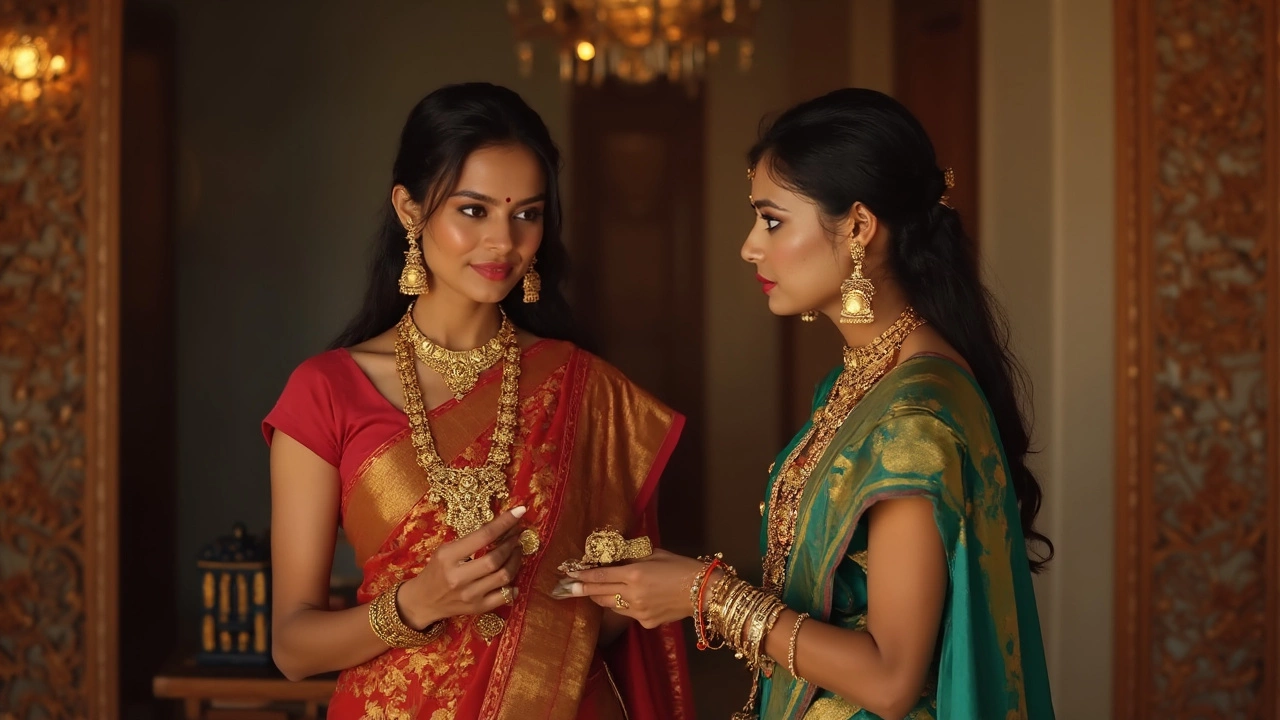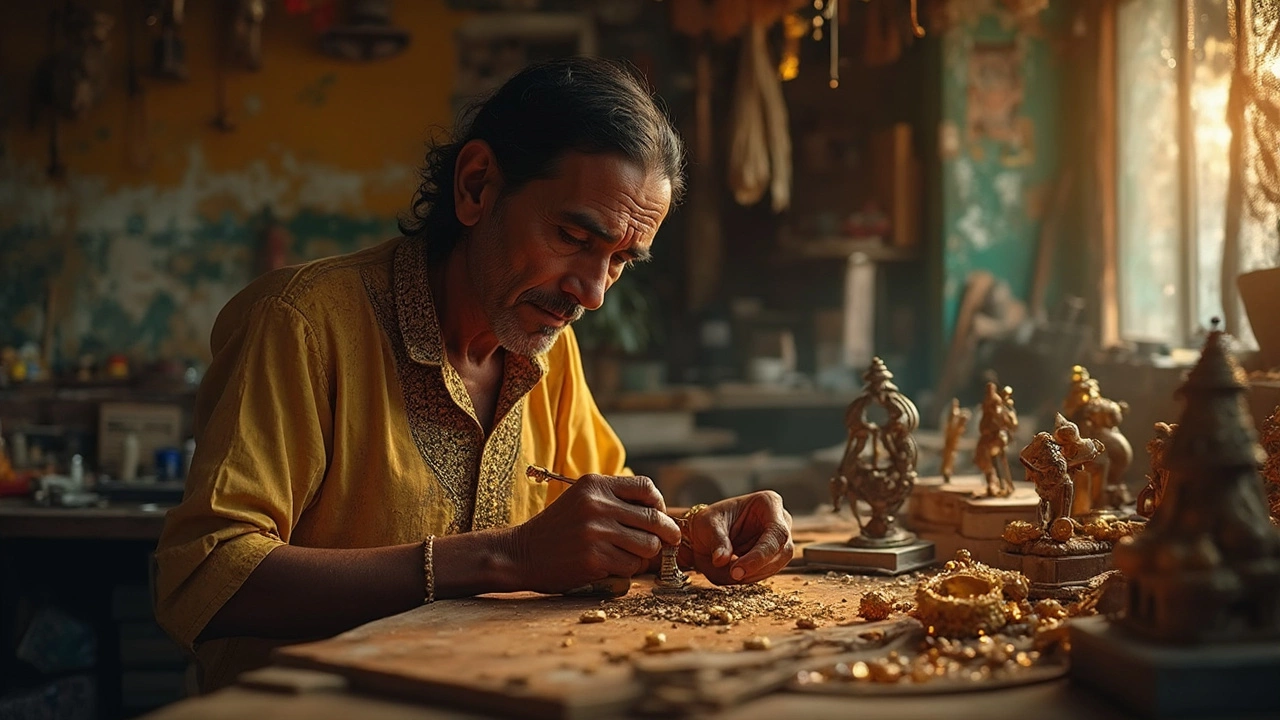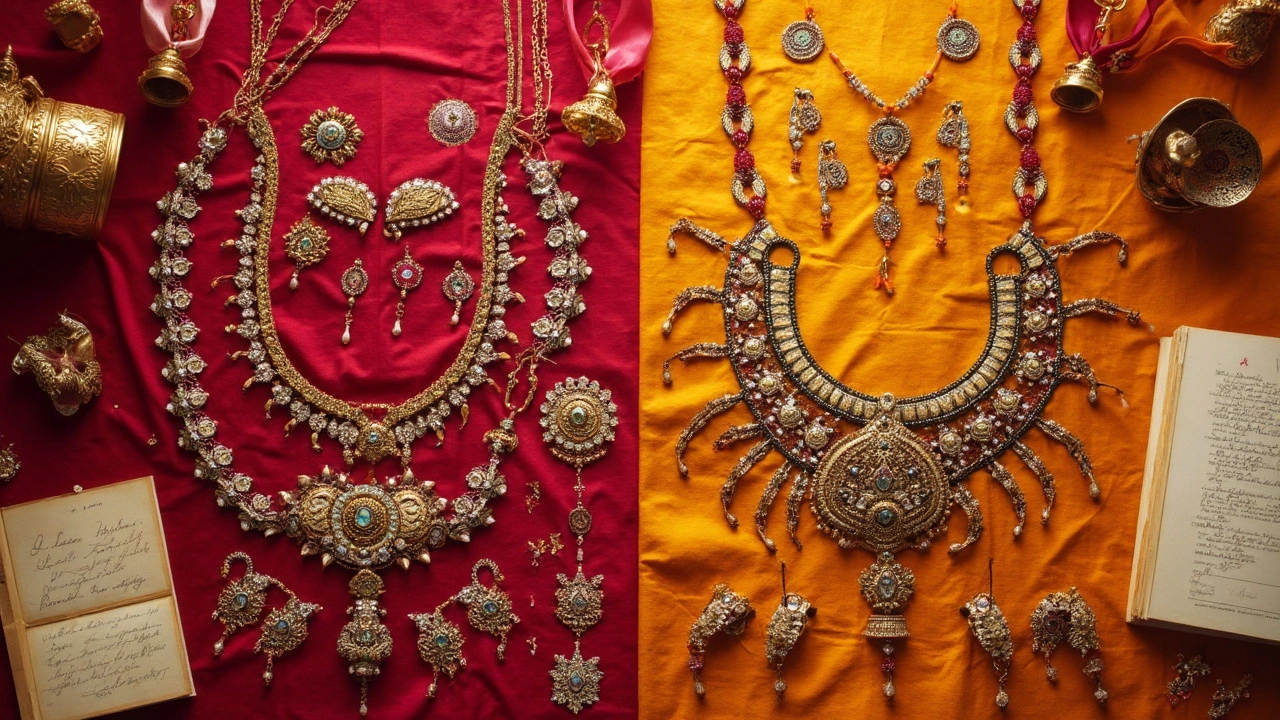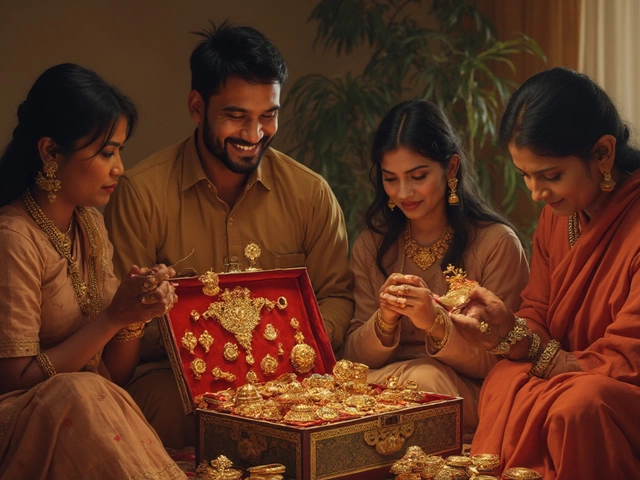
So many people mix up Nakshi jewellery and temple jewellery. On the surface, sure, they seem close—both remind you of old Indian temples, classical dancers, maybe even your grandma’s wedding photos. But there’s real stuff that sets them apart. If you’re buying jewellery, collecting, or just hunting for genuine traditional pieces, getting this right can save you money and embarrassment.
Nakshi jewellery isn’t just another kind of temple jewellery. Each has its own story, style, and way of being made. Some stores use the terms like they’re the same, but that’s just confusing. The next time you spot a piece and wonder if it’s Nakshi or temple, you’ll know exactly what to look for and how not to get fooled.
- What Exactly is Temple Jewellery?
- Nakshi Jewellery: Old School Art in Modern Times
- Spotting the Differences: Key Features
- Why the Confusion Matters
- Tips for Buyers and Collectors
What Exactly is Temple Jewellery?
Temple jewellery has roots in South India, especially in Tamil Nadu and Andhra Pradesh. It’s called temple jewellery because the first pieces were made as donations for temples, or worn by deities, priests, and dancers during sacred rituals. Over time, it began showing up at weddings and festivals—not just in temples.
The most recognizable thing about temple jewellery? The designs. Expect to see goddess Lakshmi, peacocks, elephants, and lotus motifs carved right into the metal. Most temple jewellery pieces are made out of gold—sometimes solid, other times gold-plated over silver. They're chunky, bold, and made to stand out in a crowd.
- Popular items: Maang tikkas, nose rings, long harams (necklaces), earrings, and bangles.
- Crafted by hand: Goldsmiths use a technique called granulation—tiny gold balls are fused to the surface to create texture.
- Loved by dancers: Bharatanatyam and Kuchipudi artists swear by authentic temple jewellery for their classical look and heavy stage presence.
What’s wild is how long it takes to make: sometimes weeks for just one set. Some families pass these heirloom pieces down for generations. Even museums in Chennai and Hyderabad display collections that are over 150 years old.
| Feature | Temple Jewellery |
|---|---|
| Main Material | Gold, gold-plated silver |
| Common Motifs | Deities, animals, flowers, temple patterns |
| Key Users | Dancers, brides, devotees |
| Origin | South India (Tamil Nadu, Andhra Pradesh) |
If you ever wonder if a piece is true temple jewellery, check for high-relief carvings and religious symbols. Fakes use machine stamping, but the real deals are hand-worked with visible intricate details. Go for antique shops or trusted jewellers who can tell you about the history of each piece—don’t just trust the label.
Nakshi Jewellery: Old School Art in Modern Times
Nakshi jewellery goes way back, straight into the roots of South Indian artistry. The word "Nakshi" comes from “Naksh,” meaning to engrave or carve. This style is famous for the high-relief engraving techniques that make every design look almost three-dimensional. The main trick? Metal is carved by hand, pounding out goddesses, peacocks, and mythological scenes with insane attention to detail. The result looks pretty much like a tiny, wearable sculpture.
Gold is the go-to metal for Nakshi pieces, usually with hardly any stones at all. This sets Nakshi apart from other types, where stones or colored glass are often added. What you’re looking at is basically artistry in metal. Most traditional Nakshi work comes from Tamil Nadu and Andhra Pradesh, but there are workshops today popping up in cities like Hyderabad and Chennai, keeping the craft alive while tweaking it for new tastes.
One thing’s for sure: making Nakshi jewellery isn’t quick or cheap. Masters can spend weeks on a single necklace. This makes these pieces rare and highly valued, especially for weddings or temple ceremonies in southern India.
| Fact about Nakshi Jewellery | What It Means |
|---|---|
| Technique | Hand-engraved, high-relief metalwork |
| Main Material | 22k Gold |
| Origin States | Tamil Nadu, Andhra Pradesh |
| Common Motifs | Gods, goddesses, animals, temple scenes |
| Modern Cities Making Nakshi | Chennai, Hyderabad |
These days, Nakshi isn’t just for the stage or big temples. You’ll see new-age designers creating Nakshi-inspired earrings and rings for everyday use. Some even mix silver with gold to keep prices down, but if someone calls a piece "genuine Nakshi," it better be hand-carved and mostly gold.
One tip: If you want to own a genuine Nakshi jewellery piece, always ask for details about the making process. Machine-pressed designs get passed off as handmade sometimes, so don’t be shy with your questions. Real Nakshi work has those deep, bold engravings you can actually feel with your finger—almost no two will look exactly the same.

Spotting the Differences: Key Features
If you line up temple jewellery and Nakshi jewellery side by side, there are clear signs to spot which is which. Both look stunning but come from different ideas and making techniques. Here’s what really sets them apart.
Temple jewellery goes way back to the South Indian temples. Look for chunky necklaces, bold chokers, and earrings with big pendants—usually showing deities or religious scenes. Almost every piece is made in pure silver or gold, and is heavy in your hand compared to modern stuff. Dancers, especially in Bharatanatyam, use temple jewellery with red and green stones that pop from a distance.
Nakshi jewellery stands out for its surface work. "Nakshi" means carving, and that’s what you get—crazy detailed hand-carving. Artisans use tiny chisels to craft gods, flowers, peacocks, elephants, and geometric designs right onto gold sheets. Put simply: Nakshi’s magic is all about how much detail you can pack into a piece. It’s more about textures and patterns than just bling. The making is so labor-intensive that one necklace can take weeks, even months.
- Temple jewellery: Inspired by idols, uses lots of motifs like Lakshmi, peacocks, and lotus. You’ll see stones set right into the metal.
- Nakshi jewellery: Focuses on 3D hand-carved designs, minimal use of stones, and a very textured, almost sculpted look.
- If it looks smooth and flat with plain metal shapes: Probably temple.
- If it’s got little carved details everywhere: Most likely Nakshi.
Want a quick comparison?
| Feature | Temple Jewellery | Nakshi Jewellery |
|---|---|---|
| Main Motif | Religious icons, goddesses | Hand-carved figures, flora, fauna |
| Material | Gold, silver (sometimes gold-plated) | Gold, mostly with deep engravings |
| Texture | Smoother, bigger pieces | Highly detailed surface, 3D effect |
| Stone Setting | Red/green stones, pearls | Few or no stones, more about carve work |
| Origin | Based on temple art of South India | Traditional hand-carving craft |
One more thing: Nakshi can sometimes show up as a technique in temple jewellery, especially in custom pieces. But pure Nakshi is all about the carving, while temple jewellery is about the religious or cultural meaning. Check the details, see what stands out, and you’ll always pick the right one.
Why the Confusion Matters
The mix-up between Nakshi and temple jewellery is more than a small mistake—it's a big deal when it comes to buying, selling, or even valuing these pieces. Both have solid reputations, but they're made differently, with their own stories and cultural backgrounds. Get it wrong, and you could end up overpaying or missing out on an authentic design. Sellers sometimes use these names loosely, either because they don’t know better or want to make a sale. This doesn’t help anyone, especially if you’re after something original and valuable.
The problem pops up most with dancers and buyers who want jewellery for special events. Bharatanatyam dancers, for example, were traditionally known to wear temple jewellery—pieces inspired by the gods and goddesses sculpted in South Indian temples. Nakshi, on the other hand, is all about the way the gold is hand-carved, using detailed patterns and figures, often drawing on legends and folklore. The distinction matters if you want historical accuracy or a certain look.
Here's a quick look at how easily these terms get swapped around:
| Jewellery Term | Typical Use | Common Confusion |
|---|---|---|
| Nakshi | Hand-carved ornaments, lots of detail | Labeled as temple jewellery in ads |
| Temple Jewellery | Inspired by temple idols, traditional wear | Marketed as Nakshi due to similar looks |
This confusion also affects pricing. Real temple jewellery, especially antique pieces, can cost twice as much as Nakshi. If you don't know the difference, you might end up paying a premium for something that's not as rare or old as advertised.
- If you’re a collector, double-check authenticity before buying.
- Ask sellers clear questions about the origin and type of the piece.
- Look for certifications or trusted sources, especially when shopping for important occasions.
Bottom line, knowing the difference can help you make better choices. You get what you really want—and you’re not just paying for a fancy label.

Tips for Buyers and Collectors
Trying to pick between Nakshi and temple jewellery? Don’t get swept up by pretty pictures or clever sales pitches. What really matters is what you’re getting for your money and whether it matches what you want.
- Check the craftsmanship: Temple jewellery features gods, goddesses, and spiritual symbols as mini sculptures—think chunky studs, Lakshmi pendants, Ganesh earrings. Nakshi, on the other hand, is all about deep hand-carved designs and rich textures, often scenes or borders with a 3D look. If it feels flat, it’s probably not Nakshi.
- Ask for the origin: Original temple jewellery comes mainly from places like Nagercoil and Kanchipuram in Tamil Nadu. Nakshi work is big in Hyderabad and South India but can pop up elsewhere too. If your seller can pinpoint the origin and craftsman, you’re likely dealing with something authentic.
- Materials matter: Traditional pieces use gold or silver, sometimes set with rubies, emeralds, or pearls. If it looks too shiny or light, it could be plated brass—nothing wrong with that if you know what you’re buying, but don’t pay gold prices for it.
- Check for hallmarks and certification: Real gold or silver should have a proper BIS (Bureau of Indian Standards) mark, or at least some certification. Don’t be afraid to ask, especially if you’re spending big.
- Know the use: Temple jewellery is classic for Bharatanatyam and Kuchipudi dance. Nakshi is sometimes more flexible—great for festivals, weddings, or just showing off something unusual. Buy what fits your need, not what just looks cool in a store.
For collectors, dig into the background of a piece—who made it, how old it is, any past owners. This stuff can boost resale value. And if you’re buying online, check seller ratings and customer photos, not just staged product pics.
The more you learn, the less likely you’ll get fooled or miss out on a piece that’s perfect for you. There’s nothing wrong with owning both types, but knowing the details helps you choose wisely every single time.


